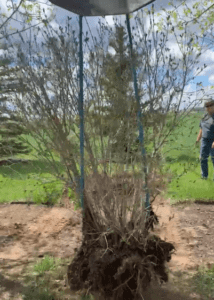This spring, we took on the task of transplanting a couple of our beloved lilac bushes. It was an exciting yet careful process, ensuring these beautiful shrubs would thrive in their new location. Here’s a peek into how we accomplished this with the help of some handy equipment and a bit of gardening knowledge.
The Process

Digging Up the Lilacs
We began by digging up the bushes before the leaves fully emerged. This is crucial as plants are best transplanted while they are dormant, typically in the spring or fall. Winter transplanting isn’t feasible because the ground is frozen, making digging impossible.
Using a skid steer with a U-blade, we carefully excavated the bushes. This tool allowed us to dig deep enough to preserve the lilacs’ extensive fibrous root system, which is vital for their successful transplantation.
Transporting Lilac Bushes with Care
Once the bushes were dug up, we used a tow rope to transport them across the yard to their new home. The other side of the yard offers more room for growth, ensuring that these lilacs can spread out and flourish without constraint.
Why Timing Matters
Timing is everything when it comes to transplanting. As mentioned, the dormancy period in spring and fall is ideal because the plants are not actively growing, reducing the stress on them during the move. Lilacs, with their resilient root systems, handle transplantation quite well, making them a reliable choice for gardeners looking to revamp their landscapes.
The 10-Year Rule
This particular lilac bush was around 10 years old, a significant age in the lifecycle of garden plants. At the decade mark, flower beds often need a revamp. When we initially design flower beds, we plant with about 75% of the mature size in mind. Planting with full maturity in mind often leaves the area looking sparse and open for several years. The 75% rule strikes a balance, creating a lush appearance that pleases homeowners without overcrowding the space too quickly.
Landscaping Realities
It’s interesting to note that show homes are sometimes over-planted to create an instant, eye-catching look. This approach helps sell homes faster but isn’t ideal for long-term garden health. Such plants are often removed well before the 10-year mark.
A Growing Garden
With our lilacs now in their new, spacious location, we look forward to watching them grow and thrive. Gardening is full of these little adventures and learnings, many of which might seem trivial until you find yourself immersed in the process. Whether you’re a seasoned gardener or a beginner, there’s always something new to discover.
So, next time you’re in your garden, remember that even the most mundane tasks, like transplanting a bush, can be a step towards creating a beautiful, thriving outdoor space. Happy gardening!
Want some skilled help in transplanting bushes in your garden? Reach out to us to let us know about your next project.







